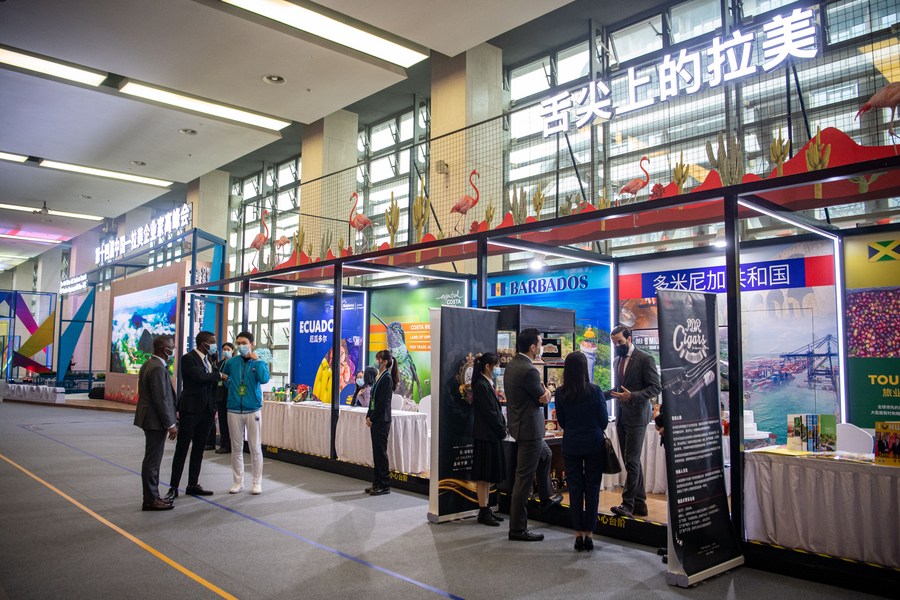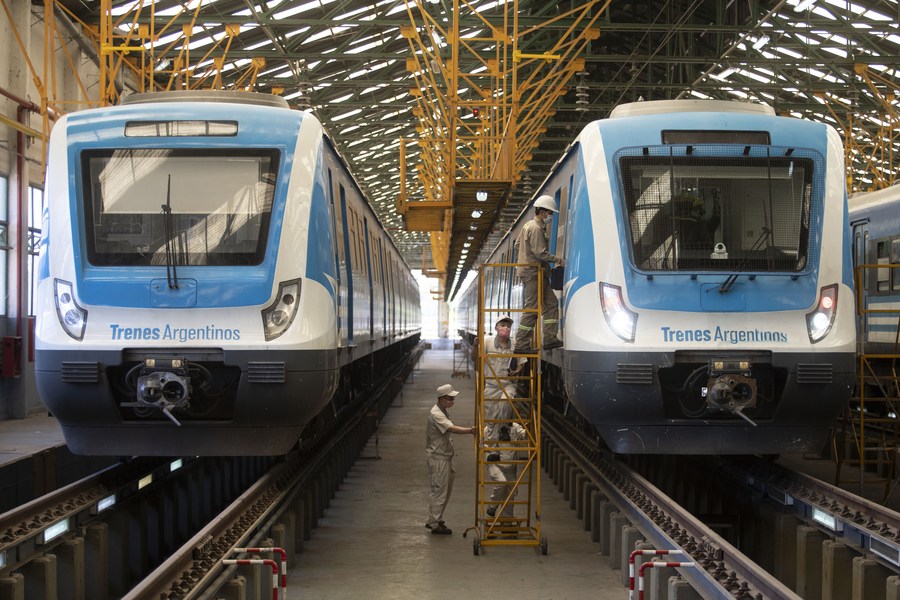China, LAC countries embrace new era of win-win cooperation

People visit an exhibition during the 14th China-Latin America and the Caribbean Business Summit in southwest China's Chongqing on Nov. 16, 2021. [Xinhua/Tang Yi]
MEXICO CITY -- For decades, Argentines have dreamt of having a hydroelectric power plant on the Santa Cruz River, one of the last large free-flowing rivers in the region of Patagonia encompassing the southern end of South America, so that they could be less dependent on energy imports.
But the plan to build one was on ice at one point because of the engineering challenges of adverse weather conditions like freezing temperatures and perennial gusts, as well as environmental impacts given the river's proximity to an iconic glacier.
Now, thanks to Argentina's determination and Chinese expertise, Argentines are about to witness their dream coming true.

Chinese engineers and technicians with CRRC Qingdao Sifang Co., Ltd., together with their Argentine colleagues, inspect a train in Llavallol, some 33 km south of Buenos Aires, Argentina, Nov. 16, 2020. [Photo by Martin Zabala/Xinhua]
BREEZE OF THE BELT AND ROAD
On the first day of the Year of the Rabbit, when most of the Chinese people across the world were still enjoying their Spring Festival vacation, Chinese engineer Xiong Yongfeng went to work on the construction site of the Nestor Kirchner-Jorge Cepernic Hydroelectric Power Plant on Santa Cruz. Upon arrival, Xiong took out some construction blueprints, and started a heated discussion with Argentine engineers on site. Surrounding him and his Argentine colleagues were running machines and moving construction vehicles.
Xiong was one of the 50 Chinese staff remaining on duty during the festival break. Together with Argentine staff, they ensured that the construction is progressing smoothly, so that ordinary Argentines could be a step closer to their "energy dream."
Besides increasing energy sufficiency in Argentina, the project has improved the living conditions of many, generating jobs and building roads for the local communities. Braving numerous challenges, Chinese and Argentine engineers have also guaranteed the environmental sustainability of the project, as the plant has been designed with fish passes and ecological bottom wells.
Argentina is not the only Latin American country working with China on infrastructure construction under the framework of high-quality Belt and Road cooperation. The reconstruction of the Eloy Alfaro International Airport in the Ecuadorian city of Manta, which was hit hard by a powerful earthquake in 2016, has enhanced the country's trade, tourism and business ties with the rest of the world; a UHV power transmission lane stretching from north to south in Brazil, a country abundant in energy but limited by unequal distribution, has brought benefits to 22 million Brazilians, or 10 percent of the country's population.
Eduardo Regalado, a researcher at the International Policy Research Center of Cuba, said the Belt and Road Initiative (BRI) has given a strong boost to the development of relations between China and Latin America and the Caribbean (LAC) countries.
China has played a key role in promoting infrastructure construction in Latin America, while economic and social development in the region has injected new impetus into China-LAC relations, Regalado said.
As Chinese President Xi Jinping said in a video address delivered at the seventh Summit of the Community of Latin American and Caribbean States (CELAC) held Tuesday in Buenos Aires, more and more countries in the region have engaged in high-quality Belt and Road cooperation with China, supported and participated in the Global Development Initiative and the Global Security Initiative, and are working with China in building a China-LAC community with a shared future.
BILATERAL TRADE IN BLOOM
Dalian Port in northeast China has opened a direct shipping route to import cherries from Chile.
Earlier in the month, the ship GSL Tinos, loaded with 616 twenty-foot equivalent units of Chilean cherries, docked at the container terminal in Dalian after a 22-day trip.
Of the total, 592 TEUs of cherries would be delivered directly to the wholesale markets in China. The others would be transferred to the Republic of Korea via Dalian Port.

A worker weighs nectarines in a factory of Agricola Garces in Mostazal, Chile, on Jan. 19, 2018. [Xinhua/Xu Rui]
Chilean cherries are increasingly favored by Chinese consumers, and the market demand continues to rise. "China has become our main market and strategic partner," said Victor Maroto, a representative of Chilean shippers.
In addition to Chilean cherries, blueberries from Peru and beef from Uruguay are also among the best-selling products in China, especially during the Spring Festival. In Guangzhou in southern China, Ecuadorian roses and Colombian hydrangeas have become good choices for local people to decorate their houses.
During the fifth China International Import Expo held in November 2022 in Shanghai, Latin American companies showcased such quality products as Argentine wine and Colombian chocolate, hoping to take a bigger share in the Chinese market.
Meanwhile, Latin American countries have become important markets for Chinese companies. In Ecuador, Chinese vehicles lead the automobile market as consumers are increasingly drawn to their design, sticker price and innovative features. Automobiles, vans, SUVs and trucks of more than 40 Chinese brands are estimated to be sold in Ecuador.
Even during the pandemic, bilateral trade has showed strong vitality. Data from China's General Administration of Customs showed that in 2022, the total trade value between China and Latin America and the Caribbean exceeded 450 billion U.S. dollars for the second consecutive year.

The Angel of Independence monument is lit up in red to mark the 50th anniversary of diplomatic ties between China and Mexico in Mexico City, capital of Mexico, Feb. 14, 2022. [Xinhua/Xin Yuewei]
TOGETHER TOWARD A BETTER FUTURE
In Mexico, the "home of corn," China's technical cooperation with the International Maize and Wheat Improvement Center (CIMMYT) is making steady progress.
Bram Govaerts, director general of CIMMYT, said the collaboration with China can be regarded as one of the mutually beneficial examples of working together to safeguard the world's food security.
"CIMMYT and China together can be partners," said Govaerts. "CIMMYT can work with China for new wheat varieties that can fight climate change, for new maize varieties that can sustain new diseases."
China and Latin America have set a good example of South-South cooperation, and they are expected to carry out more exchanges and cooperation through such multilateral platforms as the China-CELAC Forum in the future, so as to jointly benefit the world, Argentine sociologist Marcelo Rodriguez said.
In Tuesday's video address, Xi said: "We highly value our relations with CELAC, and take CELAC as our key partner in enhancing solidarity among developing countries and furthering South-South cooperation. That is why China has been working with LAC countries to steadily strengthen the China-CELAC Forum and take the China-LAC relationship into a new era characterized by equality, mutual benefit, innovation, openness and benefits for the people."
In fighting the COVID-19 pandemic, vaccine cooperation between China and multiple Latin American countries has helped protect people's lives and health. China-LAC cooperation in science and technology innovation has also yielded fruitful results, including China-Brazil Earth resources satellite cooperation and an astronomy research center jointly launched by China and Chile.
As Xi said in the video address, China is ready to join forces with LAC countries to promote world peace and development, build a community with a shared future for mankind, and open up an even brighter future for the world.
























